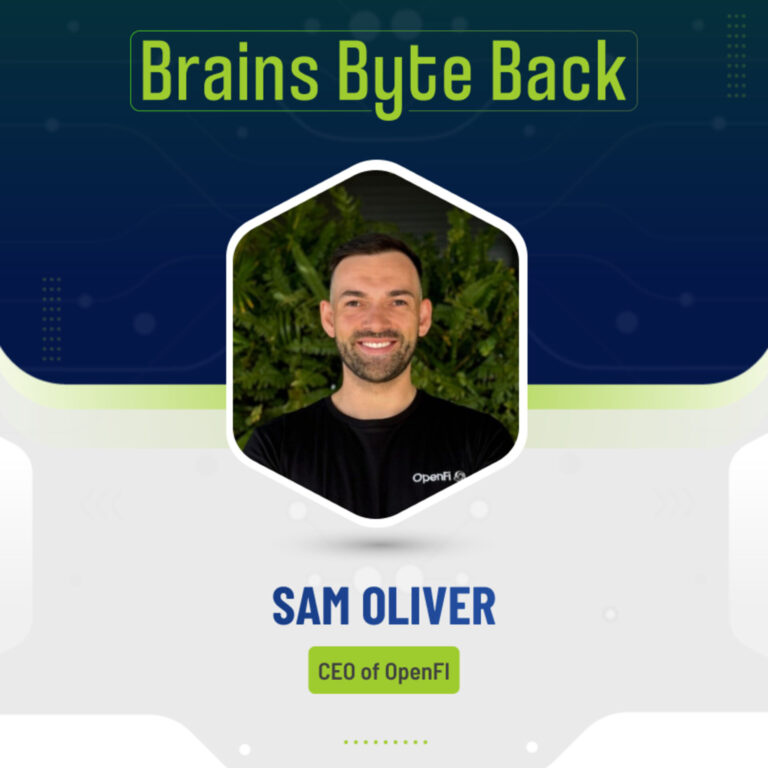In this episode of Brains Byte Back, we explore the evolution of communication. Quickblox founder Nate MacLeitch and host Erick Espinosa start the podcast by discussing how Quickblox is serving the growing needs of companies looking to elevate their communications across the board.
Nate explains that the software is an all-encompassing communication platform that provides real-time correspondence through various channels. The company is on an exciting journey after adding a layer of generative AI capabilities that can be used in multiple ways to make communication that much more efficient, including real-time summary transcriptions and knowledge assistance.
Nate explains how the field has evolved in the past 30 years. From landline dials to texting, from messaging apps like WhatsApp to collaborating tools like Slack, we’re currently witnessing the next stage of the evolution of communication: AI. He explains how his career journey in the early days of working in the field of SMS technology eventually led him to create QuickBlox. Responding to a growing need for companies who saw value in integrating that functionality in their apps and websites. Today he continues to provide that service in an elevated format through the added layer of AI.
Erick asks whether he’s seeing more customers because of a heightened interest in AI. Which Nate confirms that QuickBlox has always had a consistent need for companies looking for real-time communication tools, pre-Chat GPT. Especially within the healthcare industry, through requirements like virtual consultations. However, the increased functionality of AI has become a game-changer in many ways. By becoming a participant in conversations, taking unstructured data, and converting it into a knowledge source for those seeking answers to their questions, the technology is improving the communication process in many ways, according to the QuickBlox CEO.
Nate makes an interesting point that whether or not you’re keen on AI, individuals and companies have to figure out how to adapt the technology into their workflow in a way that derives additional value from its use.
You can listen to the full episode below, or on Spotify, Anchor, Apple Podcasts, Breaker,, Google Podcasts, Stitcher, Overcast, Listen Notes, PodBean, and Radio Public.
Find out more about Nate Nate MacLeitch here.
Find out more about QuickBlox here.
Connect with Brains Byte Back host Erick Espinosa here.
Transcript:
Nate MacLeitch
Hi, I’m Nathan MacLeitch, CEO of QuickBooks. And we provide communication with AI integrated as a part of it.
Erick Espinosa
Nate, thank you for joining us on this episode of Brains Byte Back. It’s actually your second time on the show, and we’re delighted to have you back. Let’s begin by giving our listeners some insight into what quick blocks is exactly.
Nate MacLeitch
Hi, Erick. Thanks for having me on the show. Again, I appreciate it. Quickblox is a communication platform provider that provides real-time communication for apps, websites, and companies. So what does that mean? We provide real-time chat, live video, calling and video conferencing, and file sharing. On top of our core platform, we have some embeddable apps for basic telemedicine and AI assistants, which you can plug into websites. And the kind of excitement that I have right now is that we’ve added a whole layer of generative AI capabilities within our real-time communication platform to enable AI assistants and CO pilots to help provide real-time summary transcription, translation, and knowledge assistance to kind of any type of real-time communication application or website.
Erick Espinosa
You’ve been in the digital comm field for quite some time, so I’m sure you’ve seen the progression in terms of communication tools, you know, growing, right? We’re seeing a lot of different types of options becoming available. Can you start from the beginning, giving us an idea of where the idea for Quickblox initially came from?
Nate MacLeitch
Yeah, no, that’s a great question. And I think we’ve all seen how communication has evolved over the past, you know, 20 30 years, going from people dialling on phones and landlines to then moving towards, you know, mobile phones and communication that way. From the adding of texting and SMS to the rise of messaging apps like WhatsApp and others to, you know, slack for collaboration tools. And now the latest innovation in communication, which is really the enhancement of AI. Earlier in my career, I was involved with media and then got involved in the early days of the SMS industry and believe that it was a time when SMS was obviously not as commonplace and needed to be used in different applications.
Erick Espinosa
How early? How early are we talking about here?
Nate MacLeitch
SMS would have been about 2000 to 2003, which is when it started coming into, like consumer applications. So you basically do all the texting and kind of revolution. The SMS was originally designed as an internal messaging layer that engineers can use to communicate with each other and cell phone networks. And then, they made it publicly available so that users could text one another. And then from SMS, obviously, with the rise of the iPhone and smartphones, you now have a plethora of apps and the ability to communicate through the internet. So, that was obviously the rise of messenger apps like WhatsApp and moving forward with communication. So, in terms of my background, I sold SMS gateways in the early days of those technologies. Moved to running a variety of businesses doing kind of mobile content, moving the old ringtone boom when people used to have ringtones and have chat services on their phones through SMS. And then moving to actually providing that as a service. So basically other companies and websites could kind of add this kind of functionality to their own apps and their websites. And then finally, with Quickbox, enabling those communication services. And now, with the added layer of AI, because AI is now can be a participant within chats, it can do things like intake and triage of people asking questions, it can do things like customer care. And so I think the generative AI revolution really adds a whole new layer, where it’s actually transforming the way that we communicate with one another and between machines and humans.
Erick Espinosa
Are you seeing an uptick in people reaching out to you interested in this because of AI? Or can you identify a certain year or a certain time when you felt like more people were gravitating towards looking at your platform as a potential tool to connect with customers?
Nate MacLeitch
Yeah, so I mean, our platform and our communication tools predated kind of the launch of chat GPT and other areas. And so we’ve always kind of had a consistent need for companies who want to add, you know, real-time communication to their apps, and specifically, we work with a number of different healthcare companies who want to enable, like private, you know, virtual consultation or we do consultations. But with the addition of AI on top of this capability as functionality, it becomes a game changer. Because AI now can be a participant in that conversation, so can transcribe your conversation, it can summarize your conversation, and it can take a lot of different inputs of unstructured data. And unstructured data in the form of communication is like text messages like, you know, voice is like video calls. So AI has a really great ability to take this unstructured data and kind of put it into the ability to analyze that and then provide, you know, relevant, hopefully, useful information. The other advantage of AI and in terms of real-time communication, is it can also serve as a knowledge assistant. So, it can take this unstructured information, map that against the database, or map those questions against some sort of knowledge source. And it can help provide answers to people who have got questions that could be, you know, as simple as, hey, what’s the return policy of this item I bought online, where they can do that through some sort of chat interface. To provide detailed information about side effects from official prescriptions that they might be taking, to help define a workflow or to find knowledge within an organization that might be in some Google Docs somewhere. So to provide useful information for the end user. So there are a ton of ways that AI can improve the communication process.
Erick Espinosa
So it’s a game changer for most industries.
Nate MacLeitch
Yeah, yes, definitely. And I mean, I think it’s one of these things that you know, whether or not you like it, you have to figure out how to adopt this technology into your business and your workflows. And I think that’s both for individual people at their jobs and companies that are providing products. They all need to figure out how they can derive additional value from the use of AI in their services.
Erick Espinosa
Recently, your company announced a chatbot feature built as a communication tool for the healthcare industry, which you touched on. Can you talk to us a little bit more about focusing on that niche in that sector?
Nate MacLeitch
Yes. So historically, we’ve had a number of customers use our messaging platform for a variety of different healthcare use cases, it could be something like peer support for cancer patients where they are able to text each other and get support that way. We’ve had a use by a company who’s doing care navigation and organ transplant management, so like chronic care management. We’ve had a use for telemedicine use cases, and we’ve kind of got a ready telemedicine app that people can take embed within their application. So based on our experience of seeing, you know, a variety of different use cases of healthcare and some of the problems they have in that industry. I mean, they’ve got issues of shortages of doctors and nurses, there’s a high administrative burden where consultations need to be transcripted, and needs to basically make sure you’re getting the right information or the right prescription. So there’s a lot of administrative overhead. We thought this was an industry that certainly could benefit from the use of AI in their workflows, and especially within real-time communication. So, we created a HIPAA-compliant AI assistant that can be plugged into applications. Bearing in mind the importance of protecting patient data, we also need to provide doctors, nurses, and the admin staff with the ability to have a knowledge assistant or the ability to access AI functionalities in a safe way so that they can generate information. Or they can streamline administration processes through the use of AI and other applications. So what does this mean in like real practice, rather than kind of the abstract. So like, if you’re coming to a website, and you want to book an appointment, and you want to talk about your symptoms, you can have the AI, do some sort of like triage to be able to gather information about you as a patient as little as understanding what your problems are. And then they can really give that as a summary to the doctor or nurse admin staff, so they’re better prepared to do to kind of treat you it could also be something like when you’re on a virtual consultation with a doctor, right, and either the doctors take notes, or you have to take notes in the process. So the AI can listen in the background and it can take a transcription of that call. And then that call can be formatted into the form of a note that the doctor would use. And they can also capture the information you might say like, Hey, you got, you know, chest pain, are you going to her arm then it can actually also help provide, you know, diagnostic codes that the doctor can then, you know, refer to as part of the conversation. So there are a number of different areas where the use of AI within, you know, the real-time communication experience can actually create a lot of additional efficiencies. That’s an industry which obviously has got a lot of problems, right? There are a lot of areas in healthcare that can use some efficiency. And I think all parties in the healthcare delivery chain would be quite happy if they could have more efficiency in that process.
Erick Espinosa
Before developing the tool, I imagine you were doing a little bit more research in the sector. Did you feel there was maybe a hesitation when it came to the healthcare industry in terms of the technologies that they were to choose to integrate? It’s a type of industry that faces a lot of cyber attacks, ransomware, and you know, those numbers seem to be going up. But it does have to be compliant with regard to the regulations of the government. What was the process of building a technology that was HIPAA compliant? Is that the way you pronounced it earlier…?
Nate MacLeitch
Yeah, HIPAA. Yeah.
Erick Espinosa
Okay. Yeah, to make sure that it was compliant. Because from what I understand, it’s one of the first AI chatbot tools that that have that kind of certification.
Nate MacLeitch
Yeah, well, HIPAA is a certification, it’s actually a law. And so with that, there’s a number of laws that the HIPAA Act basically requires the protection of a PHI, you know, protected health information. And so that kind of governs a person’s health care data should be treated. You make sure that data is stored in an encrypted format. You make sure that any connection between exchange of that data is done through encrypted connections. And then in the case of, like, AI, you also want to make sure that that data does not leave your organization and go train up some other AI model with any kind of personal information. And so, we had experience of doing HIPAA-compliant chat and communication through a messaging platform. So then, when we wanted to add the additional AI capabilities, it was really important it still had best practices to protect personal data but could also be used by the doctors who want to use it. And so, we have sought compliance, which is part of the requirements. There is data that is encrypted at rest and encrypted in connection. And coming back to your original question about healthcare organizations using new tools and AI. Yeah, I think there are some genuine concerns about how AI is going to impact the care delivery process. And I think those are good questions to ask, right? Because, first of all, a person’s health data is one of the most precious, you know, data about that individual. And, you know, they want to make sure that they have a right to privacy, that information isn’t going to be widely distributed, or that it is going to be distributed to someone else, and that it’s under their consent. And it’s done in a way that’s appropriate. And then second, from the physician’s point of view, they want to ensure that there’s accuracy and verifiability if they’re going to be providing some information or getting a third party like AI to kind of analyze a patient’s case and provide some recommendations. So we built a number of tools with our HIPAA-compliant AI assistant where you still have a human in the loop. So the questions can be verifiable, and the data that can be generated by the AI is traceable. So you can see the source of that information. And it can be, you know, reviewed before it’s shared or communicated. So we do have pluggable chatbots that can gather information and provide customer care, but we have some rules built in. So that needs to have a human handover that that message or that communication can be basically put in front of the human being for review before, you know, it gets modified and changed. So yeah, in terms of the healthcare industry, security is definitely paramount. And obviously, prediction of privacy, about their data is very, very, very important, as you said.
Erick Espinosa
As a digital communication expert who has been in the field for a little while now, do you feel like the regulations are keeping up with the technology? AI right now seems to be really exploding and advancing very quickly. I imagine you have to balance both. You have to keep an eye on what’s going on with the updates with compliance, and at the same time, you’re keeping an eye on the developments of the technology.
Nate MacLeitch
Yeah, with us, it’s something that internally, we’re always looking to see how we continue to evolve our products in ways that take advantage of the latest changes in this technology while being mindful of practical use cases. There’s still a lot that AI can do without having to take the latest bit of technology, right? There are still lots of efficiencies you can add, like summarization, adding some kind of form to triage or intake users, or providing answers against the knowledge base. So I think that the current AI tools, as they exist today, can still add a lot of utility and value as this technology path continues to evolve, and you add things into it. I do think that for a number of use cases, I mean, if you’re not looking at regulated industries, like health care, like we are, there are issues about consent and how AI is interacting with you. I wrote an article a while back that was talking about that. How AI can add value, but AI is taking your data is like a one-way trip, and it’s using that to manipulate or is using that in ways that are ethically minded. It can definitely create problems. So coming back to regulation, as we all know, typically, is after the horse has bolted from the stable. So I think there is a lot of public policy that we need to address. A lot of these issues around making sure that as AI is implemented across applications and services that there are some controls in place, and there are some ways that there’s traceability of how that AI interacted with those people for those outcomes. But yeah, it is scary if you think about the ability of AI to clone voices or images or the rest of it. You know, it kind of puts the Nigerian prince scams on steroids, right? So, yeah, we definitely need to be mindful of how we implement these technologies moving forward.
Erick Espinosa
Oh, that’s already happening. 2023, I think they painted that picture in terms of people taking AI companies to court with regard to intellectual property because of how their systems are trained. But I think we’re just going to be hearing more and more about it. Obviously, those court cases, I think, will set a precedent, but the more discussions we have like this, you know, it opens that door to understanding what the impacts are and how to navigate them.
Nate MacLeitch
Yeah. And also, I mean, it’s kind of different countries that have different regulatory regimes. So, you know, court cases in one country may not be as applicable, and others in terms of ensuring best practices. So I think there definitely has to be some responsibility on the part of technology vendors to make sure that that’s done properly, as well as, you know, industry working together with government to get some common sense regulations. These processes are just happening, right
Erick Espinosa
Of course. From what I understand, the E.U. is really taking the lead with that.
Nate MacLeitch
Yeah, the E.U. has traditionally done that. So GDPR is something that we’ve dealt with for a long time. And California basically has their own California Consumer Privacy Act as well, which basically leans pretty heavily on what had been done with GDPR in the EU. General Data Protection Regulation. So I think the EU, again, is kind of taking the lead, and hopefully, there’ll be a clear, regular path. So companies kind of know best practices to operate.
Erick Espinosa
And outside of AI, what do you think is the next big trend in digital communications?
Nate MacLeitch
Um, I think that’s a hard one because I think AI is so transformative that there are so many different aspects of AI that will transform digital communications if that makes sense. So, you know, when we talk about AI, you know, there’s different aspects of AI, right? There’s AI that you can use for knowledge assistance, summarization, using things like a rack, which is, you know, kind of an engine retrieval, augment generation to kind of gather information, but train database, but you also got things like digital workers and agents that you can start to ask them to do stuff for you. Just because of the fact that we now have a natural language interface as a command line. And so what does that mean? Right, you now have a box, which you can type something into, and the computer on the other end can understand what you asked it to do, like in the world, of Star Trek, it will do it for you, and that can now be done by voice or via text. So I think, how does that impact on, you know, communications, basically comes pretty ubiquitous, that you’re going to ask your AI to do stuff for you, and it will go out and do it or answer questions for you or to help make things more efficient. So I think communications, tying in with AI agents will unlock a lot of productivity. And I see that is kind of just the tip of the iceberg in terms of the changes we’re gonna be seeing over the next, you know, 10, 20 years.
Erick Espinosa
That’s a great response. It really makes you think, to be honest. Nate, is there anything else that you wanted to touch on that we didn’t get an opportunity to chat about? Maybe you think that our viewers should be aware of… OH, sorry! Our listeners should be aware of?
Nate MacLeitch
I think it’s a pretty exciting time right now. Because right now, you have like traditional enterprise software and like the internet as it exists today. And then in parallel, you have this AI revolution going on there. And so basically, all these things are gonna mash up at some point. And so the way that you interact with software and services, you know, are all going to change. Hopefully, the call centers will get a lot better if they can gather the right information so you’re not kept on hold for 30 minutes or hours at a time. Hopefully, you’ll be able to get better outcomes with your healthcare if you can provide better information analysis for professionals from a lot of different areas. So I think there’s a lot of promise around creating better efficiency. I think, obviously, with those changes that we’ll also have some differences on unemployment. I think AI is a lot better at doing white-collar jobs, and anyone thought it would be in terms of providing content writing or analysis or other areas. So I think, you know, we need to shape our society to kind of take advantage of this technology while figuring out how people can stay gainfully employed and continue to thrive.
Erick Espinosa
Nate, thanks again for joining us on this episode of Brains Byte Back. We really appreciate your insight.
Nate MacLeitch
Yeah, thanks for having me. Appreciate it.

Disclosure: This article mentions a client of an Espacio portfolio company.












